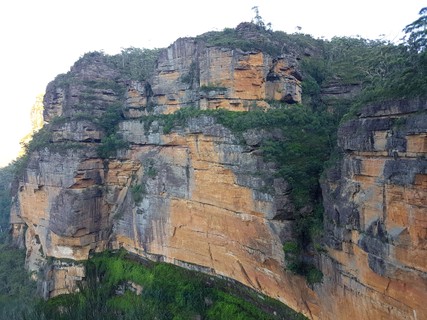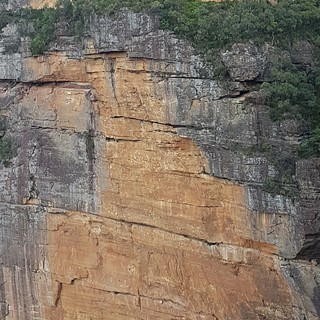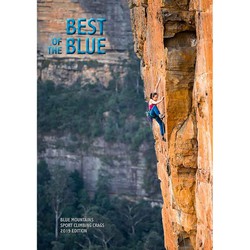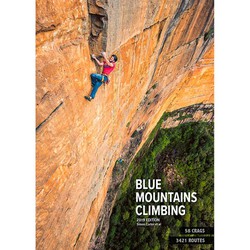

description
Mostly trad, mostly choss. Major crackline splitting the orange wall. Very overhung. Best to fix a 100m static and short fix down the route. The bottom belay is about 10m above the ground which is a ferns and mud. Rack should be triples of cams 0.3 - 0.5, doubles of cams 0.75 to 3, single of cams 4 & 5. The 5 can be left at pitch 4 belay as its only needed on the last pitch. Approach: It's best to fix ropes rather than attempting to use double ropes and pull them down after you. There are two ways to rap down depending on how much you want to pre-inspect what you plan to climb back up. If you just want to get down quickly and inspection free use the FH and ubolt anchor (same approach as for Superdyke). Rap straight down corner, down Superdyke and continue down below that route using trad and occasional bolt to stay connected to the wall. Option B rap which goes straight down the route - use the single lone Ubolt further left (back it up with the FH/ubolt to the right). This way down requires a lot of kick swinging, short fixing on each belay and leaving occasional bits of trad behind. It's mega steep!
15m (17) Overhung trench of choss. All trad. Hanging belay off bolts
35m (24) 3 bolts up face to where the "fun" begins. Boldly launch up overhung wall, following intermittent seam, and through two small roofs to small ledge belay. This pitch takes a lot of finger sized cams.
12m (22) Pretty ghastly steep. Exposed flakes of choss to lone bolt. Wiggle a #4 in the mud slot above this then launch into steep pumpy fisty crack. Belay on small ledge (DRB)
25m (22) Traverse right across wall on flakes then mantle up to small ledge. Finish up the top section of Superdyke (bolts).
Route history
| Route setter: Heath Black | |
| 3 Oct 2021 | First ascent:
Paul Frothy Thomson & Heath Black Neil led pitch 1, Paul led pitches 2, 3 and 4 |
Warnings
Location
- Lat/Lon: -33.58507, 150.36305
Grade citation
| 24 | Assigned grade |
| 24 | ★private |
ethic
Although sport climbing is well entrenched as the most popular form of Blueys climbing, mixed-climbing on gear and bolts has generally been the rule over the long term. Please try to use available natural gear where possible, and do not bolt cracks or potential trad climbs. If you do the bolts may be removed.
Because of the softness of Blue Mountains sandstone, bolting should only be done by those with a solid knowledge of glue-in equipping. A recent fatality serves as a reminder that this is not an area to experiment with bolting.
If you do need to top rope, please do it through your own gear as the wear on the anchors is both difficult and expensive to maintain.
At many Blue Mountains crags, the somewhat close spacing of routes and prolific horizontal featuring means that it is easy to envisage literally hundreds of trivial linkups. By all means climb these to your hearts content but, unless it is an exceptional case due to some significant objective merit, please generally refrain from writing up linkups. A proliferation of descriptions of trivial linkups would only clutter up the guide and add confusion and will generally not add value to your fellow climbers. (If you still can't resist, consider adding a brief note to the parent route description, rather than cluttering up the guide with a whole new route entry).
If you have benefited from climbing infrastructure in NSW, please consider making a donation towards maintenance costs. The Sydney Rockclimbing Club Rebolting Fund finances the replacement of old bolts on existing climbs and the maintenance of other hardware such as fixed ropes and anchors. The SRC purchases hardware, such as bolts and glue, and distributes them to volunteer rebolters across the state of New South Wales. For more information, including donation details, visit https://sydneyrockies.org.au/rebolting/
It would be appreciated if brushing of holds and minimisation/removal of tick marks becomes part of your climbing routine. Consider bringing a water squirt bottle and mop-up rag to better remove chalk. Only use soft (hair/nylon) bristled brushes, never steel brushes.
The removal of vegetation - both from the cliff bases and the climbs - is not seen as beneficial to aesthetics of the environment nor to our access to it.
Remember, to maintain access our best approach is to 'Respect Native Habitat, Tread Softly and Leave No Trace'. Do not cut flora and keep any tracks and infrastructure as minimal as possible or risk possible closures.
For the latest access related information, or to report something of concern, visit the Australian Climbing Association NSW Blue Mountains page at https://acansw.org.au/blue-mountains/
Seasonality
Quality
Overall quality 50 from 2 ratings.
Tick Types
Comment keywords
Selected Guidebooks more Hide
Author(s): Simon Carter
Date: 2019
ISBN: 9780958079075
Simon Carter's "Best of the Blue" is the latest selected climbing guide book for the Blue Mountains and covers 1000 routes and 19 different climbing areas. For all the sport climbers out there, the travellers, or just anyone who doesn't want to lug around the big guide that's more than 3 times the size - cut out the riff-raff and get to the good stuff! This will pretty much cover everything you need!
Author(s): Simon Carter
Date: 2019
ISBN: 9780958079082
The latest comprehensive, latest and greatest Blue Mountains Climbing Guide is here and it has more routes than you can poke a clip stick at! 3421 to be exact. You are not going to get bored.
Accommodations nearby more Hide
Share this
Get a detailed insight with a timeline showing
- Ticks by climbers like you
- Discussions of the community
- Updates to the index by our users
- and many more things.
Login to see the timeline!


